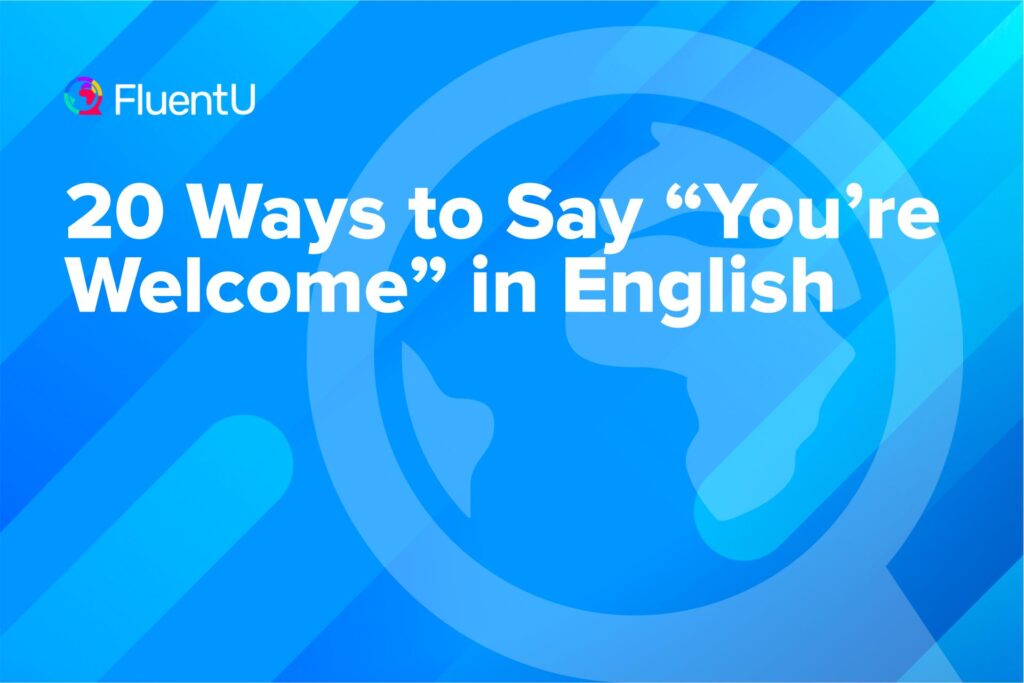20 Ways to Say “You’re Welcome” in English

When someone thanks you for helping them, what do you usually say? Is it “you’re welcome” or something else?
Some English phrases are used too much. That’s why it’s important to learn different ways to say the same thing. In this blog post, you’ll learn how to say “you’re welcome” in English with 20 different phrases.
You can also check out this video lesson from our YouTube channel:
Download: This blog post is available as a convenient and portable PDF that you can take anywhere. Click here to get a copy. (Download)
Formal Ways to Say “You’re Welcome”
- My pleasure
- I’m happy to help
- I’m glad to help
- I’m happy to be of assistance
- Happy to be of service
- I’m sure you’d do the same for me
- The pleasure is mine
- You’re most welcome
You might notice that many of the more formal variants of “you’re welcome” imply that a service has been performed.
That’s because you’ll most commonly hear and use these expressions in places such as restaurants, banks, public buildings and other locations where there are people who do a specific job.
Informal Ways to Say “You’re Welcome”
- It was nothing
- No problem
- It’s no trouble
- Anytime
- Sure
- Sure thing
- No worries
- Don’t worry about it
- Don’t mention it
- No big deal
- Of course
- Absolutely
You might notice that these are much shorter. They are more commonly used in everyday interactions, such as helping somebody on the street, lending an object to a friend and other daily interactions.
There’s generally a lot of crossover between these expressions. This is because formal and informal English is becoming less distinct (different).
Why Say “You’re Welcome” in English
It’s Part of Good Manners in English
As you might know, English is a very polite language with a long history of manners and customs (traditions). This is especially prominent (obvious) in British culture.
This is a type of polite behavior known as “etiquette.” It’s very important to use when interacting with other English speakers.
In fact, the English people are known for their politeness, so learning your manners in English is pretty important, and can help you sound like a native speaker.
To Respond to “Thank You”
In its simplest form, “you’re welcome” is used as a polite way to respond to a person who thanks you after you have helped them or complimented them.
For example:
“Hey, can I borrow your pen?”
“Yes, of course!”
“Thank you.”
“You’re welcome.”
As you can see, it tells the other person you’ve accepted their “thank you.”
To (Rudely) Remind Someone That They Didn’t Thank You
Sometimes you’ll hear “you’re welcome” used when no one said “thank you.”
This is a way to remind someone they need to thank you or make fun of them for forgetting.
But be careful—this should only be used as a joke between friends. Otherwise, it’s very rude.
For example:
John: “Hey, can I borrow your pen?”
Susan: “Of course!”
John forgot to say “thank you.”
Susan: “You’re welcome!”
The intonation in this context will be different, with a heavier emphasis on the welcome. As I said earlier, you should only use “you’re welcome” like this with your good friends.
If you aren’t sure about where to place the intonation, you can watch how native speakers do it with authentic content, such as movies, TV shows and vlogs. There’s also the FluentU program.
FluentU takes authentic videos—like music videos, movie trailers, news and inspiring talks—and turns them into personalized language learning lessons.
You can try FluentU for free for 2 weeks. Check out the website or download the iOS app or Android app.
P.S. Click here to take advantage of our current sale! (Expires at the end of this month.)

You can see different examples of “you’re welcome” in clips from TV shows, movies and a variety of other content. This helps improve your usage and understanding of the common phrase.
Invite Someone to Do Something
“You’re welcome” can also be used as a polite invitation. It’s a great way to invite somebody without a feeling of social pressure or sounding too demanding.
For example, maybe you’re going away on holiday and aren’t using your car. You know that your friend’s car stopped working, so you want to let them know they can use your car if they want to.
In this case, you’d say something like:
“You’re welcome to use my car while I’m on holiday.”
It’s also a very common sentence to hear when you’re at a friend’s house, and although you weren’t planning on staying for dinner, they’d like to invite you to stay for a meal.
For example:
“You’re welcome to stay for dinner if you’d like!”
Bragging About Something You Did
Sometimes it’s not uncommon to hear people use “you’re welcome” when they’re bragging (being very proud in an arrogant way) about an achievement or accomplishment.
Once again, you shouldn’t use “you’re welcome” in this way unless talking to your close friends or family.
Take a look at this clip from the movie “Moana,” where Dwayne Johnson sings the song “You’re Welcome.”
Because he’s a demigod and created the oceans and the sun, he proudly sings throughout the song, “What can I say except you’re welcome!”
Take a look at another example below:
John: “Wow, this dinner looks amazing!”
Susan: “You’re welcome!”
It’s as if to say, “No need to thank me, I already know how good I am!”
It’s often used in a situation that we call “tongue in cheek” (not serious) and can be quite funny if it’s done correctly (like in “Moana”).
Are you feeling confident about how to say “you’re welcome” appropriately now?
If you can think of other ways to say it, then make a list and keep adding to it as you learn and hear more of them.
Challenge yourself to use some of these phrases to add variety to your English! You’ll be sounding more native in no time.
You’re welcome!
Download: This blog post is available as a convenient and portable PDF that you can take anywhere. Click here to get a copy. (Download)
And One More Thing...
If you like learning English through movies and online media, you should also check out FluentU. FluentU lets you learn English from popular talk shows, catchy music videos and funny commercials, as you can see here:
The FluentU app and website makes it really easy to watch English videos. There are captions that are interactive. That means you can tap on any word to see an image, definition, and useful examples.
For example, when you tap on the word "searching," you see this:
Learn all the vocabulary in any video with quizzes. Swipe left or right to see more examples for the word you’re learning.

FluentU helps you learn fast with useful questions and multiple examples. Learn more.
The best part? FluentU remembers the vocabulary that you’re learning. It gives you extra practice with difficult words—and reminds you when it’s time to review what you’ve learned. You have a truly personalized experience.
Start using the FluentU website on your computer or tablet or, better yet, download the FluentU app from the iTunes or Google Play store. Click here to take advantage of our current sale! (Expires at the end of this month.)










